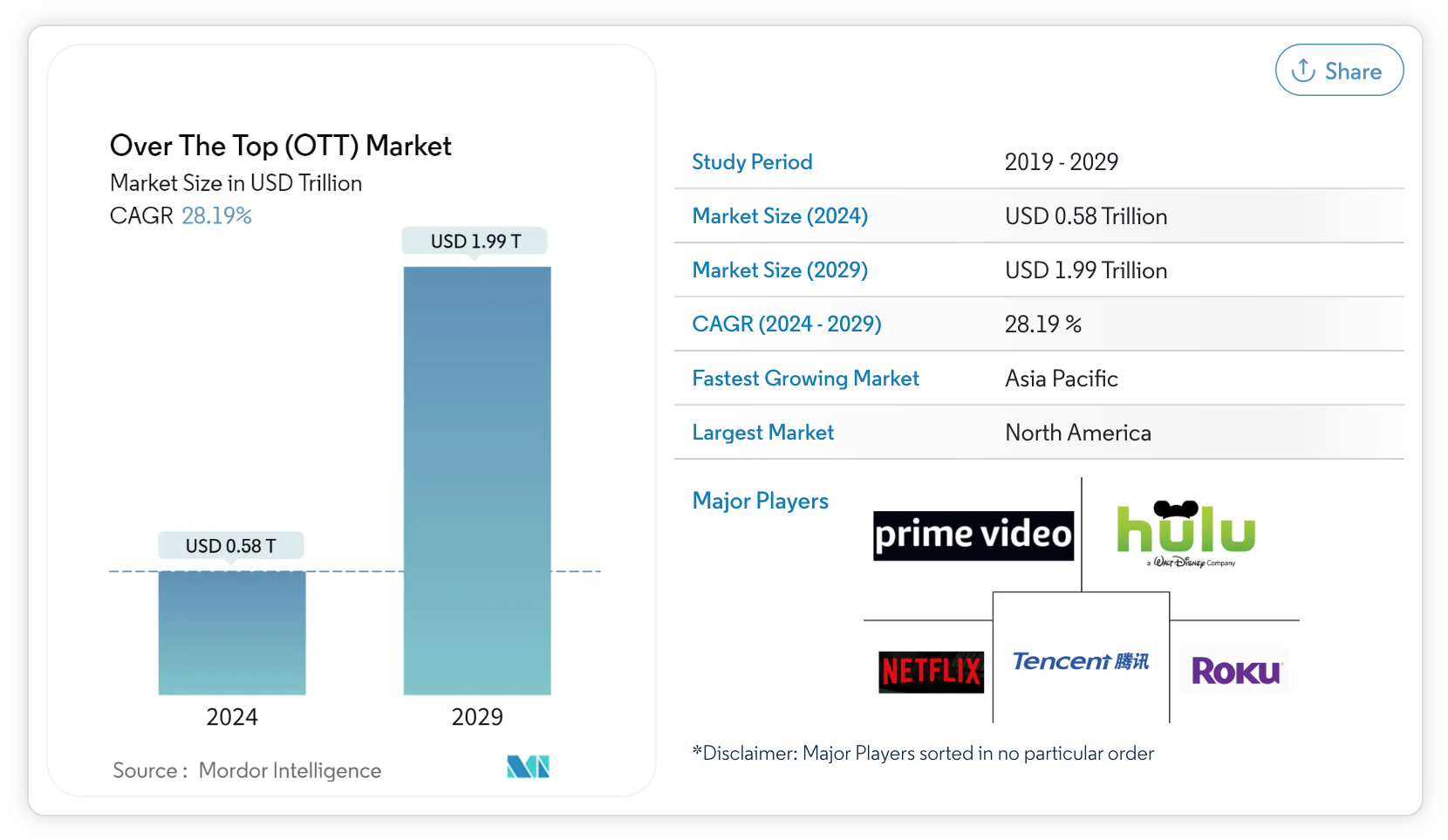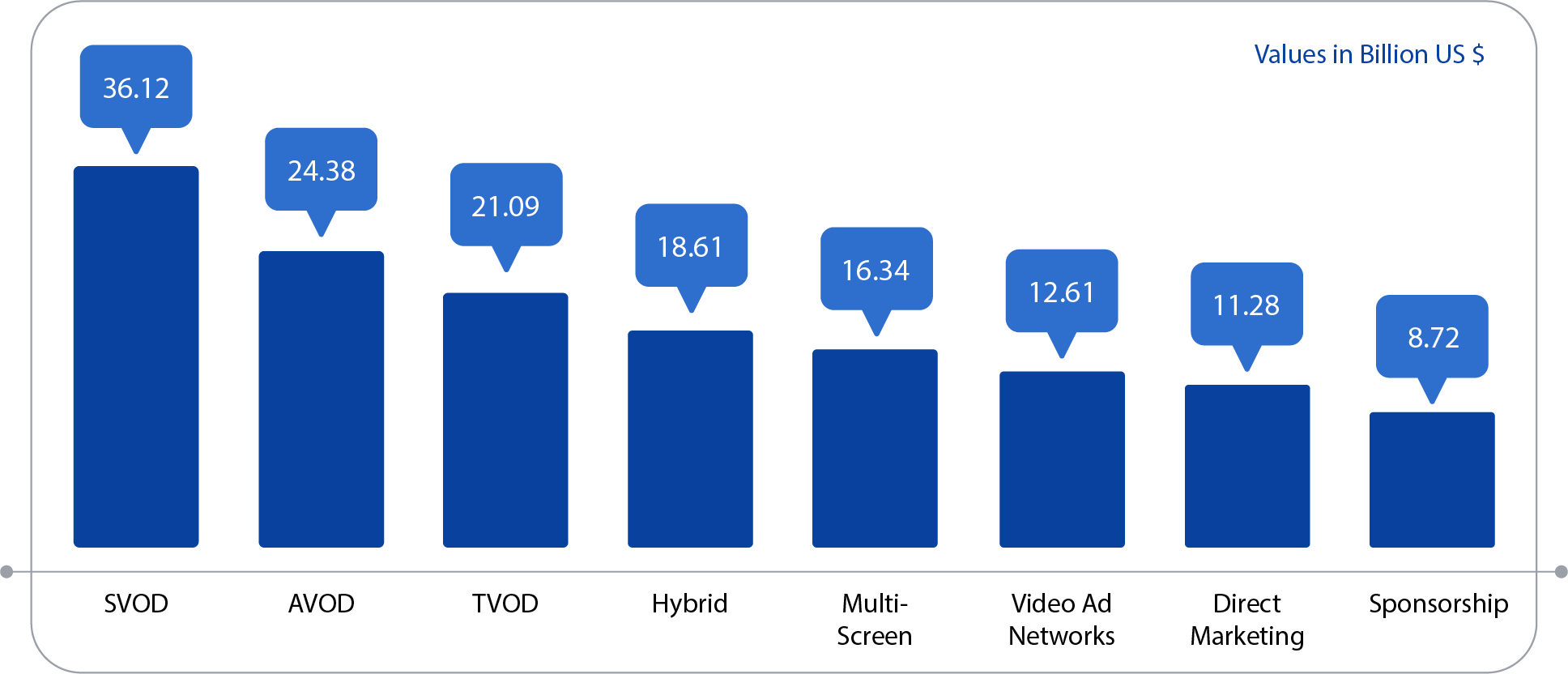BLOG

Date: 10 April 2024
The OTT landscape is booming, with audiences increasingly turning to streaming services for their entertainment fix. But for media companies, the question remains: how to effectively monetize your OTT channel and fund the creation of high-quality content?
The global over the top (OTT) market size was valued at US$ 200 billion in 2022 and it is expected to hit around US$ 2057.47 billion by 2032, registering at a CAGR of 26.30% from 2023 to 2032.

Source: Mordor Intelligence Research & Advisory. (2023, September). https://www.mordorintelligence.com/industry-reports/over-the-top-market
While subscribing to your favorite streaming service might seem like the only way OTT platforms make money, there’s more to the story. We’ll explore the various revenue streams that keep these entertainment giants afloat, from the familiar to the innovative.

Here are 10 creative strategies that go beyond traditional subscriptions, along with data to showcase their effectiveness and potential for generating new content:
Offer a limited selection of free content with the option to purchase premium shows, seasons, or exclusive behind-the-scenes extras. This caters to budget-conscious viewers while generating revenue for premium content.
Example: Crackle (owned by Sony Pictures) offers free movies and TV shows with optional in-app purchases for newer releases.
Provide multiple subscription tiers with varying pricing and features. Higher tiers could offer ad-free viewing, early access to new content, or the ability to stream on multiple devices simultaneously. This caters to different viewer preferences and generates higher revenue from dedicated fans.
Example: Netflix offers Basic, Standard, and Premium tiers with increasing features at each level.
Allow viewers to rent or purchase individual episodes or movies. This caters to casual viewers who may not want a full subscription and provides an additional revenue stream.
Example: Amazon Prime Video offers rentals alongside its Prime membership. According to a Parks Associates survey, 70% of US OTT viewers used TVOD services in 2022, highlighting its potential.

Integrate targeted advertising within the free content. This caters to a wider audience and generates revenue without requiring subscriptions. However, careful ad placement is crucial to avoid viewer frustration.
Example: Hulu offers a free, ad-supported tier alongside its subscription plan.The IAB report estimates AVOD revenue in the US to reach $32.6 billion by 2025, showcasing its growth potential.
Collaborate with brands to integrate their products or services subtly within your content. This can be a lucrative revenue stream while potentially influencing viewers’ purchasing decisions.
Example: Netflix’s show “Stranger Things” partnered with Coca-Cola, resulting in subtle product placements within the series.
Introduce interactive elements within shows, allowing viewers to influence the storyline or participate in polls. Additionally, host live events (concerts, Q&A sessions) with premium access for subscribers. This enhances viewer engagement and creates a sense of exclusivity, potentially justifying subscription fees.
Example: Netflix experimented with interactive elements in the children’s show “Buddy Thunderstruck.” Disney+ hosts exclusive live events for its subscribers.

Create original content sponsored by brands that aligns with your target audience and brand identity. This provides a creative way to integrate advertising while potentially generating higher production budgets.
Example: Amazon Studios produced the docuseries “The Test: A New Era for Sports” sponsored by Gatorade.
Develop merchandise based on popular shows and characters. Additionally, foster fan communities through social media engagement and exclusive events. This leverages viewer loyalty and creates additional revenue streams beyond subscriptions.
Example: HBO Max sells merchandise based on popular shows like “Game of Thrones.”
Offer subscribers early access to new content or even theatrical releases before the general public. This incentivizes subscriptions and creates a sense of exclusivity for dedicated viewers.
Example: Disney+ offered early access to the live-action remake of “Mulan” for its subscribers.
Leverage viewer data to understand content preferences and target advertising more effectively. This data can also inform future content creation decisions, ensuring content resonates with the audience.
Example: Netflix uses viewer data to personalize content recommendations and suggest shows viewers might enjoy.

While tiered subscriptions can be a reliable source of income, a combination of these strategies is often most effective. Freemium models with IAPs can attract a wider audience and convert some to paying subscribers. Similarly, AVOD can generate revenue from casual viewers while tiered subscriptions cater to dedicated fans.
Ultimately, the optimal monetization strategy depends on your target audience, content library, and brand identity. Experimenting with different models and analyzing data will help you create a sustainable revenue stream that allows you to continue producing high-quality content and keep viewers engaged.
++++++++++++++++++++++++++++++++++++++++++++
Please email marketing@logituit.com to discover how Logituit can assist you in optimizing your revenue and providing numerous monetization opportunities through its AI-powered engagement platform, LogixEngage.
Also read:
SHARE THIS ARTICLE
Stay up to date on latest trend in video tech
Related Posts
ALL RIGHTS RESERVED © LOGITUIT 2025 ( A registered trademark of EMTARANG TECHLABS PVT. LTD.)
To provide the best experiences, logituit.com use technologies like cookies to store and/or access device information. Consenting to these technologies will allow us to process data such as browsing behaviour or unique IDs on this site. Not consenting or withdrawing consent, may adversely affect certain features and functions.